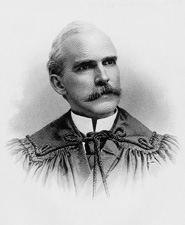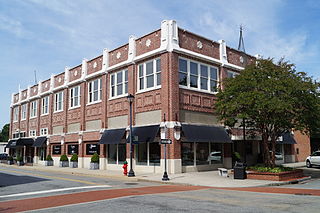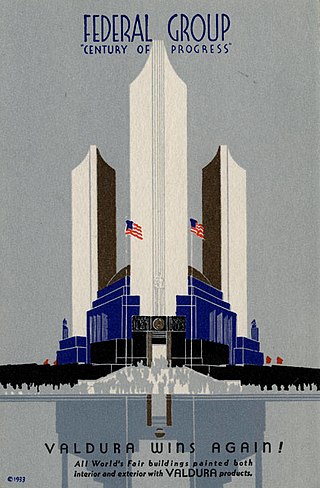
Joseph Haynsworth Earle was a United States Senator from South Carolina.
William Augustus Edwards, also known as William A. Edwards was an Atlanta-based American architect renowned for the educational buildings, courthouses and other public and private buildings that he designed in Florida, Georgia and his native South Carolina. More than 25 of his works have been listed on the National Register of Historic Places.

The U.S. Post Office and Courthouse, built in 1933, is an historic United States Post Office and federal courthouse building located at 120 12th Street in Columbus, Georgia. It was designed by Atlanta-based architect William Augustus Edwards who designed nine South Carolina courthouses as well as academic buildings at 12 institutions in Florida, Georgia and South Carolina. On September 29, 1980, it was added to the National Register of Historic Places.

This is a list of the National Register of Historic Places listings in Greenville County, South Carolina outside the city of Greenville.

Anderson Downtown Historic District in Anderson, South Carolina, originally built in the late 19th century, is a historic district that was listed on the National Register of Historic Places in 1979.

The United States Bankruptcy Courthouse, Tallahassee, Florida, is a courthouse of the United States District Court for the Northern District of Florida.

The U.S. Post Office and Courthouse is a historic post office and courthouse located at Charleston in Charleston County, South Carolina. The building and its annexes serve the federal court for the Charleston Division of the United States District Court for the District of South Carolina. The building was listed on the National Register of Historic Places in 1974.

The Joseph F. Weis, Jr. U.S. Courthouse is a Beaux Arts-style building in Pittsburgh, Pennsylvania, US. It is a courthouse for the Western District of Pennsylvania, a United States district court. Until 2015, the building was known as the US Post Office and Courthouse-Pittsburgh.

Old Greenville City Hall is a former building in Greenville, South Carolina, originally built as the U.S. Courthouse and Post Office in 1889 on the corner of Main and Broad Streets. Transferred to the city of Greenville in 1938, it served as Greenville city hall. It was listed in the National Register of Historic Places on August 19, 1971, and was removed in 1973 after its demolition.

The U.S. Post Office and Courthouse-Baton Rouge, also known as Federal Building and U.S. Courthouse, in Baton Rouge, Louisiana, was built in 1932. It includes Art Deco and Moderne architecture. It served historically as a post office, as a courthouse, and as a government office building.

The Federal Building, formerly the U.S. Post Office, Courthouse and Federal Building, is located in Downtown Sacramento, California.
Eric Kebbon was an American architect.

Halifax Historic District is a national historic district located at Halifax, Halifax County, North Carolina, US that was listed on the National Register of Historic Places in 1970. It includes several buildings that are individually listed on the National Register. Halifax was the site of the signing of the Halifax Resolves on April 12, 1776, a set of resolutions of the North Carolina Provincial Congress which led to the United States Declaration of Independence gaining the support of North Carolina's delegates to the Second Continental Congress in that year.

East Main Street Historic District is a national historic district located at Chesterfield, Chesterfield County, South Carolina. The district encompasses 20 contributing buildings and 1 contributing site reflecting the development of the town of Chesterfield from about 1798 to 1937. The district contains some of Chesterfield's finest architectural expression and includes: the John Craig House, a hall-and-parlor farmhouse with excellent Federal style woodwork; the Chesterfield Courthouse with its Second Empire cupola; and several vernacular residences with Queen Anne and bungalow influence. The Chesterfield Post Office is a brick building designed by notable government architect Louis Simon. The original Chesterfield Courthouse, reputedly burned by General William T. Sherman’s troops in 1865, was the site of one of the state's earliest secession meetings. A marker on the grounds of the current Chesterfield Courthouse commemorates that meeting. The Craig Family cemetery, containing graves of members of one of Chesterfield's founding families, also is included in the district.

Greenville County Courthouse, also known as Greenville Family Courts Building, is a historic courthouse located at Greenville, South Carolina. It was built in 1918, and is a Beaux-Arts style brick and concrete building with terra cotta trim. The building consists of a three-story front section, with an eight-story tower behind. The building served as the courthouse for Greenville County until 1950 when the court was moved to a new building. The Family Court of Greenville County was located then in the building and remained there until 1991.

Greenville Commercial Historic District is a national historic district located at Greenville, Pitt County, North Carolina. The district encompasses 51 contributing buildings in the central business district of Greenville. It includes buildings dated from about 1914 to 1952 and notable examples of Greek Revival and Queen Anne style architecture. Located in the district and listed separately are the Pitt County Courthouse (1911) by Milburn, Heister & Company and U.S. Post Office (1913). Other notable buildings include the Proctor Hotel (1911), Montgomery Ward Department Store (1929), Dail-Hodges Building (1919), Blount Building (1924), Greenville Bank and Trust, Smith Electric Building, Greenville Municipal Building (1929) designed by Benton & Benton, Blount-Harvey Department Store (1923), White's Theater (1914), Charles Greene House (1860), and the Robert Lee Humber House (1895).

The United States Post Office, also known as the Federal Building, is a historic post office building located at Greenville, Pitt County, North Carolina. It was designed by the Office of the Supervising Architect under the direction of Oscar Wenderoth and built in 1913–1914. It is a two-story, five bay, Florintine Renaissance style stuccoed brick building on a limestone base. It has a low hip roof of terra cotta tile with overhanging eaves. The front facade features a three-bay loggia formed by arches with voluted keystones, springing from Tuscan order columns. This building served as the main post office for Greenville until 1969. It currently serves as a U.S. Courthouse.

Federal buildings in the United States house offices of the United States government that provide services to state and city level population centers. These federal buildings are often literally named Federal Building, with this moniker displayed on the property; they may share real estate with federal courthouses.


















